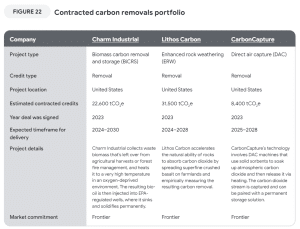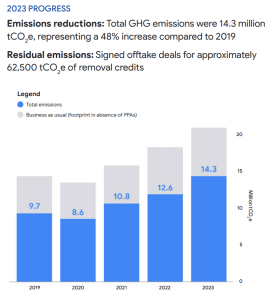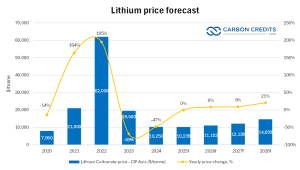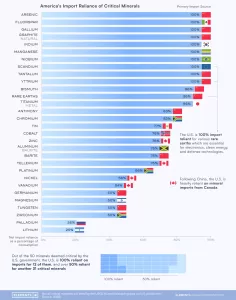Google’s Carbon Credit Expansion with Frontier’s $33M Bet on Rock Weathering
Google is making another major move in carbon removal by participating in Frontier’s $33 million offtake agreement with Eion Carbon. This deal plans to cut about 79,000 tons of CO₂ by 2030. It uses enhanced rock weathering (ERW), a natural way to boost carbon absorption in rocks.
Reilly O’Hara, Program Manager, Carbon Removal at Google, remarked on this deal, noting:
“This deal isn’t just about removing CO2 – it’s also about building a robust, transparent understanding of enhanced weathering’s potential. By integrating with existing agricultural systems and prioritizing data sharing, Eion will help pave the way for scalable, impactful climate solutions.”
What is Enhanced Rock Weathering?
Eion deploys olivine, a fast-weathering rock, on Southern and Midwestern United States farmlands. This method permanently captures CO₂ while improving soil health and crop yields.
ERW stands out from traditional carbon capture methods. It fits easily into current farming practices, making it a cost-effective and scalable solution.
ERW involves spreading crushed silicate rocks, like olivine, onto farmland. When these rocks interact with rainwater, they absorb CO₂ from the air, converting it into a stable form stored in the soil or washed into the ocean.
- Research shows that spreading crushed silicate rocks on U.S. farms could capture 0.16 to 0.30 gigatons of CO₂ each year by 2050.
Atmospheric CDR by Enhanced Weathering with US Agriculture

Eion’s research extends beyond carbon capture. The company is conducting deep soil core measurements to better understand how rock-soil interactions influence carbon storage. This data will be made public, advancing the entire field of enhanced weathering.

Visit the company’s website here to learn about its step-by-step ERW processes and how they ensure each carbon credit represents real reductions.
- RELATED: Microsoft and UNDO Partner for 15,000 Tons of Carbon Removal Using Enhanced Rock Weathering!
Farming Meets Climate Tech: The Unexpected Perks for Agriculture
Agriculture plays a significant role in both emitting and removing carbon. Soil carbon sequestration, biochar, and enhanced rock weathering are emerging as promising techniques to make farming better for the climate.
- Soil Carbon Sequestration. Certain farming practices, like no-till farming and cover cropping, can store carbon in the soil for decades. These methods can absorb up to 5 gigatons of CO₂ annually, according to the IPCC.
- Biochar. This charcoal-like substance, made from plant waste, locks carbon into the soil while improving fertility.
- Enhanced Rock Weathering (ERW). By applying reactive minerals like olivine to farmland, ERW offers a dual benefit—capturing CO₂ while enhancing soil productivity.
Benefits for Farmers
Farmers in the Southern and Midwestern U.S. are choosing Eion’s olivine-based product over traditional agricultural lime. This substitution offers several advantages:
- Cost-Effective: Revenue from selling carbon removal credits allows Eion to offer its product at a lower price than conventional lime.
- Soil Improvement: Olivine helps neutralize acidic soils, enhancing plant growth and increasing crop yields.
- Environmental Impact: By integrating ERW into their practices, farmers contribute to reducing atmospheric CO₂ levels, playing a direct role in combating climate change.
The Role of Frontier
Frontier is a group that includes Google, Stripe, and Shopify. It helps invest in carbon removal technologies. Frontier pools resources to back innovative solutions, such as Eion’s ERW. This helps speed up their development and deployment. This collaborative effort underscores the importance of joint action in addressing climate change.
Google’s investment in ERW through Eion supports the transition toward carbon-smart agriculture. This approach could transform the agricultural sector into a major carbon sink, helping offset emissions from other industries.
Beyond Offsets: Google’s History of Carbon Removal Efforts
Google has long been a leader in sustainability and carbon reduction. Since 2007, the company has been carbon-neutral, meaning it offsets all of its emissions by purchasing carbon credits. Here are its major carbon removal deals:

In 2020, Google promised to run on 100% carbon-free energy by 2030. This goal aims to cut emissions from its data centers and offices completely. Past and ongoing initiatives include:
- Investment in Renewable Energy – Google has signed power purchase agreements (PPAs) to build solar and wind farms worldwide.
- Direct Air Capture (DAC) – Google has previously supported carbon removal technologies like DAC, which captures CO₂ directly from the atmosphere.
- Forest Conservation Projects – The company has funded reforestation efforts to absorb CO₂ and restore ecosystems.
- Carbon Removal Credits – Google has backed early-stage carbon credit markets, supporting projects that remove CO₂ from the atmosphere.

The Frontier-Eion deal is part of Google’s broader commitment to carbon removal. This initiative removes CO₂ permanently, unlike traditional offsets. It fits well with Google’s long-term climate strategy.
Google’s Climate Strategy
Google aims to achieve net-zero emissions across its operations and supply chain by 2030. Now, it aims to eliminate emissions completely instead of just offsetting them.

A key goal is running on 100% carbon-free energy (CFE) 24/7 by 2030. Currently, 64% of Google’s energy use is matched with clean sources, with some regions exceeding 90%. The tech giant has also signed 80+ renewable energy deals, totaling over 9 GW of clean energy capacity.
Google has invested $200 million in early-stage carbon removal projects. The company is pushing suppliers to adopt clean energy. It is also using AI to boost energy efficiency in its data centers.
These efforts position Google as a leader in corporate climate action, setting a standard for net-zero goals worldwide.
- READ MORE: Google’s Q4 Financial Success vs. Net-Zero Pledge: Can It Balance AI Growth with Sustainability?
Carbon Capture at Scale: The Challenges and Opportunities Ahead
While ERW presents a promising avenue for carbon removal, several challenges remain. Using ERW on a large scale needs careful planning. This includes sourcing, transporting, and applying large amounts of crushed rock.
Also, accurately quantifying the amount of CO₂ removed through ERW is complex. Ongoing research aims to develop robust monitoring, reporting, and verification (MRV) frameworks to ensure transparency and effectiveness.
Lastly, reducing the costs associated with ERW is essential for widespread adoption. New methods in mining, grinding, and application can boost economic viability.
As climate issues increase, big tech firms like Google are stepping up to manage their emissions. Its partnership with Eion through Frontier’s $33 million offtake deal marks a major advancement in carbon removal. This deal highlights the importance of high-quality, verifiable carbon removal solutions. It also underscores the potential for agriculture to play a key role in climate action.
With Google’s leadership, enhanced weathering and other carbon removal technologies could scale up to remove millions of tons of CO₂ in the coming years. As the voluntary carbon market grows, initiatives like this will be crucial in the fight against climate change and the journey toward a net-zero future.
- FURTHER READING: Google, Meta, Microsoft, and Salesforce Launch “Symbiosis”, Pledging for 20M Tons of Nature-Based CDR Credits
The post Google’s Carbon Credit Expansion with Frontier’s $33M Bet on Rock Weathering appeared first on Carbon Credits.


































